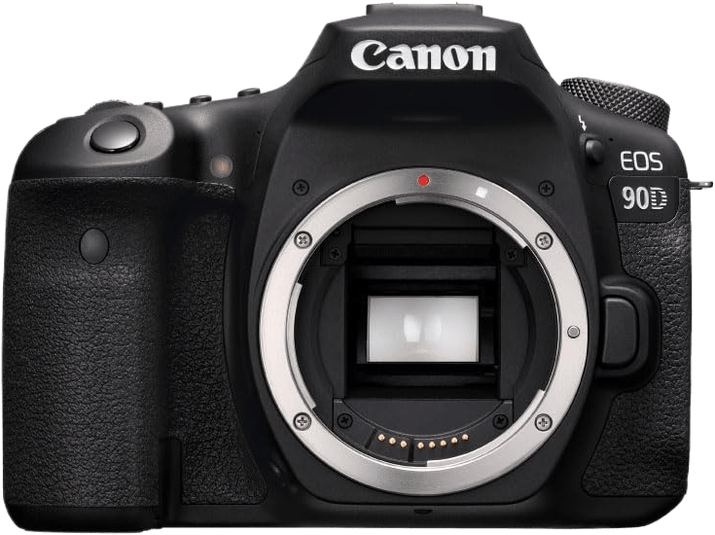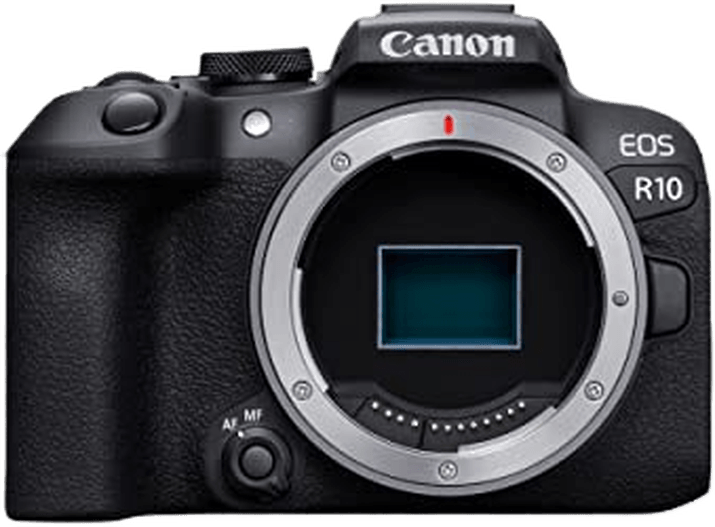Canon EOS 90D vs EOS R10 Comparison
Canon EOS 90D

Canon EOS R10

The Canon EOS R10 emerges as the winner with a score of 69/100, while the Canon EOS 90D trails closely behind with a score of 67/100. Both cameras share similarities in their announcement date, release year, and launch price. The Canon EOS R10 is a mirrorless camera announced on 05/24/2022 and released in 2022 with a launch price of $980. On the other hand, the Canon EOS 90D is a DSLR camera announced on 10/28/2019 and released in 2019 with a launch price of $1199.
The EOS R10 stands out due to its compact size, measuring 123 x 88 x 83mm, and lightweight design, weighing only 426g. This makes it more portable and easier to carry around compared to the EOS 90D, which has dimensions of 141 x 105 x 77mm and weighs 701g.
The EOS 90D, however, offers advantages in terms of its DSLR design, providing a more classic camera experience and potentially better ergonomics for some users. Despite its higher launch price of $1199 compared to the EOS R10’s $980, the EOS 90D may appeal to those who prefer DSLR cameras.
Taking all factors into consideration, the Canon EOS R10’s compact size, lightweight design, and lower launch price make it the more attractive option for most users. However, the Canon EOS 90D is still a viable choice for those who prefer the DSLR experience.
Canon EOS 90D vs EOS R10 Overview and Optics
The Canon EOS R10 outperforms the Canon EOS 90D in optics with a score of 71/100, a 9-point difference from the 90D’s score of 62/100. Both cameras share several specifications, including a CMOS sensor type, APS-C sensor size, and a lack of image stabilization. However, the R10 excels in certain areas, while the 90D has its own merits.
The EOS R10’s advantages lie in its shooting speed, processor, and DXOMARK sensor score. With a shooting speed of 15 frames per second, the R10 is faster than the 90D’s 10 frames per second. The R10 also boasts a superior Digic X processor, contributing to better image processing. Additionally, the R10’s DXOMARK sensor score is significantly higher at 97 compared to the 90D’s 58, indicating better overall image quality.
On the other hand, the EOS 90D has a higher megapixel count at 33 megapixels, compared to the R10’s 24 megapixels. This allows the 90D to capture more detail in images, which can be advantageous in certain situations. The 90D also employs the Canon EF/EF-S lens mount, providing compatibility with a wider range of lenses than the R10’s Canon RF lens mount.
Taking these factors into account, the Canon EOS R10 is the better option for those prioritizing shooting speed, image processing, and overall image quality. Meanwhile, the Canon EOS 90D is more suitable for photographers seeking higher resolution images and a wider lens selection. The choice between these two cameras ultimately depends on the specific needs and preferences of the user.
Canon EOS 90D vs EOS R10 Video Performance
The Canon EOS 90D and Canon EOS R10 both have impressive video capabilities, with each camera scoring 91 out of 100 in this category. This tie indicates that both cameras excel in their video performance. Examining their specifications, it is evident that they share several common features, such as 4K max video resolution, 3840 x 2160 max video dimensions, 120fps max video frame rate, and built-in time-lapse functionality.
The Canon EOS 90D, despite having the same video score as the EOS R10, has some advantages. One such advantage is its dual pixel autofocus system, which provides smooth and accurate autofocus during video recording. This feature makes it easier for users to capture high-quality video without worrying about focus issues. Additionally, the 90D has a longer battery life, allowing for extended video shoots without the need for frequent battery changes.
On the other hand, the Canon EOS R10 also has its unique strengths. As a mirrorless camera, it is generally lighter and more compact than the 90D, making it more portable and easier to handle during video shoots. The R10 also features a more advanced image stabilization system, which can result in steadier shots and reduced camera shake during video recording.
Given these specifications, both the Canon EOS 90D and EOS R10 are excellent choices for video recording. The 90D’s dual pixel autofocus and longer battery life make it a reliable option for users who prioritize focus accuracy and extended shooting time. Meanwhile, the EOS R10’s lightweight design and advanced image stabilization cater to those who value portability and stable footage. Ultimately, the choice between these two cameras will depend on the specific video needs and preferences of the user.
Canon EOS 90D vs EOS R10 Features and Benefits
The Canon EOS 90D outperforms the Canon EOS R10 in terms of features, with a score of 83/100 compared to the R10’s 70/100. Both cameras share several specifications, including a 3-inch screen size, 1,040,000-dot screen resolution, touchscreen capability, flip screen, and the absence of GPS. Additionally, both cameras are equipped with WiFi and Bluetooth connectivity.
The EOS 90D surpasses the R10 in the features department, which is reflected in its higher score. This advantage could result from better integration of these shared features or additional features not mentioned in the specifications. The higher score of the 90D indicates that it is a more versatile and user-friendly camera, providing photographers with an improved experience in various shooting situations.
The EOS R10, despite having a lower score, may still have some advantages over the 90D. These advantages could be related to factors such as price, weight, or specific features tailored to a particular niche of photographers. However, based on the provided specifications, it is difficult to pinpoint these potential advantages.
In comparing the two cameras, the Canon EOS 90D emerges as the superior choice in terms of features. Its higher score of 83/100, compared to the R10’s 70/100, suggests that the 90D offers a better overall experience for photographers. The R10 may have some advantages, but they are not apparent from the given specifications. Therefore, the 90D is the recommended choice for those seeking a camera with better features.
Canon EOS 90D vs EOS R10 Storage and Battery
The Canon EOS 90D outperforms the Canon EOS R10 in storage and battery, scoring 48 points compared to the R10’s 40 points. Both cameras have one memory card slot and accept SD, SDHC, and SDXC memory cards. However, the 90D is UHS-II compatible, while the R10 is only UHS-I compatible.
The 90D’s battery life is significantly longer, lasting for 1300 shots, compared to the R10’s 450 shots. The 90D uses the LP-E6N battery type, while the R10 uses the LP-E17 battery type. The R10 has an advantage in that it offers USB charging, which the 90D lacks.
Considering these factors, the Canon EOS 90D proves to be superior in terms of storage and battery life, making it a more reliable choice for extended shooting sessions. The Canon EOS R10, on the other hand, offers the convenience of USB charging, which may be useful for photographers who need to charge on the go.
Alternatives to the Canon EOS 90D and EOS R10
Are you still undecided about which camera is right for you? Have a look at these popular comparisons that feature the Canon EOS 90D or the Canon EOS R10:

